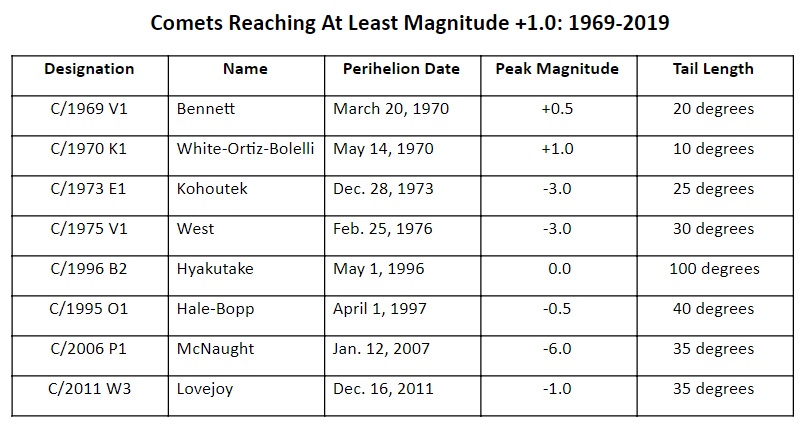Watching for Comets Will I See You Again
When Volition Nosotros See Another Bright Comet?

Recently, a friend of mine asked when nosotros might exist able to encounter a comet. He was surprised when I said in that location are several visible correct at present.
Indeed, you tin discover a list of upcoming visible comets on this useful site compiled by Japanese comet enthusiast Seiichi Yoshida. The site provides information on comets that are currently visible likewise as comets that will exist visible each month for the next five years. For this month, Yoshida lists four observable comets.
But none gets brighter than magnitude +12 (lower magnitudes are brighter), and the comets are visible only under dark, clear skies, using moderately large telescopes. Indeed, the vast majority of periodic comets — comets whose orbits are well known and have been observed more than once — fall into this category. These comets quietly come and become and are known only to enthusiastic amateur astronomers who make a concerted effort to chase them down with good binoculars or telescopes. By and large, they are unimpressive to the eye, normally actualization as naught more than than faint fuzzballs, even in large telescopes.
Related: Living on a Comet: 'Dirty Snowball' Facts Explained (Infographic)
Of course, when my friend asked his question, I knew exactly what he was alluding to: He wanted to know when we might see a stupendously bright and/or fantastically structured comet, maybe i that would develop a tail stretching a quarter of the manner or more than across the sky. Unfortunately, such objects give no advance notice equally to when they will appear. Merely with some confidence, I can state that at to the lowest degree one of these comets is heading toward the inner solar system even equally I type these words.
But whether information technology volition appear 3 weeks, 3 months or three years from now is unknown.
So what are our chances of seeing such a celestial showpiece? More on that in a moment, but first, allow'due south talk nigh what needs to happen to produce a bright comet.
Recipe for a bright comet
The unpredictability of a passing comet's appearance and brightness is no surprise to those who study these enigmatic objects. What we see depends on many variables — the comet's orbit; the relative locations of the comet, World and the sunday; and the size and composition of that icy clumping of solar organisation rubble that forms the comet's nucleus.
The nucleus'due south dusty, rocky material and frozen gases are similar to the composition of Saturn'due south rings. This part of a comet, usually merely a few miles across, is gradually warmed by the sun's heat, and expels gas and dust into space, often in distinct jets. Merely such emissions from the nucleus are oft nonuniform. To predict comets' activity, astronomers have developed general formulas and models for comet brightness based on the observed behavior of many comets going dorsum to the late 19th century. Unremarkably, a comet's activeness increases chop-chop every bit information technology draws closer to the dominicus; the effulgence typically varies (roughly) every bit the inverse fourth ability of its solar distance.
Put another way, as a comet's distance from the dominicus is halved, its brightness increases by a gene of xvi, or three magnitudes.
But comets tin be capricious and, like people, have their individual quirks. The physical appearances and behaviors of comets are every bit varied as the appearances and behaviors of people; no two are alike.
Possibly just equally important, if not more important, than a comet'due south arroyo to the sun is the comet's distance from Earth. An average-size comet tin appear stupendously large and vivid if it passes very close to Globe. An first-class case in betoken is Comet Hyakutake, which made a close approach to our planet in March 1996, coming to inside 9.5 million miles (15.3 one thousand thousand kilometers) of Earth. It reached null magnitude and was accompanied by a 100-degree tail (stretching across more than half the sky). But if Hyakutake had approached no closer than Comet Hale-Bopp (122 meg miles, or 196 million km), information technology would take appeared no brighter than magnitude +half dozen, which would have placed it right on the verge of naked-eye visibility in a non-low-cal-polluted sky.
Conversely, if Hale-Bopp — which was at its all-time in March 1997 — had passed equally closely equally Hyakutake, it would have blazed at magnitude -six, iii times brighter than Venus, with a tail stretching across the entire heaven!
The tail wags the comet
Speaking of tails, that particular bagginess might be the well-nigh of import factor in determining whether a comet tin exist branded every bit a truly prominent object. I still call up a cold Sabbatum evening in January 1986, dubbed "Halley's Comet Dark" past then-New York Mayor Ed Koch. In all five boroughs, Koch had arranged for designated locations to temporarily extinguish their normally bright lights to give his constituents the opportunity to get a better view of this famous comet, which was low in the western evening sky. At Jones Beach on Long Island, about 40,000 people gathered to grab a glimpse of Halley. Local astronomy clubs set telescopes for the general public. I brought my x-inch Dobsonian telescope and used low power to provide a dainty broad-field view. The line of people patiently waiting for a look was incredibly long, but later on peering through the eyepiece and seeing only a small-scale, nebulous patch with a starlike center, virtually every person asked the aforementioned question: "Where's the tail?" One nonplussed adult female seemed to speak for everyone when she exclaimed (a flake like Lucy from the Peanuts comic strip), "What skilful is a comet if it doesn't have a tail?"
Indeed, a comet tin get brilliant yet lack a tail. In May 1983, Comet IRAS-Araki-Alcock passed within 2.ix meg miles (4.7 1000000 km) of Earth and, within a calendar week, sped across the sky, resembling nothing more than than a fuzzy ball of calorie-free well-nigh the size of the moon. Then, there was Comet Holmes in October 2007, which unexpectedly flared in less than 2 days from magnitude +17 to +2.5. To the unaided eye, it appeared more than like a nova, a moderately vivid yellowish star, in the constellation Perseus.
And then, it appears that the tail is what determines how impressive a comet volition look to the average person.
Related: Amazing Comet Photos by Stargazers
Cast of comets
At present dorsum to the original question: When might nosotros come across another bright comet? In the table below, I take listed the brightest comets that have appeared over the by l years. There are eight on the listing, making an average of one about every vi.25 years. Of form, they didn't appear precisely at 6.25-year intervals. In 1970, for case, Comet Bennett — which put on a spectacular bear witness in late March and early April — was followed in May by Comet White-Ortiz-Bolelli, a rare sungrazing comet. In contrast, Comet Lovejoy, another sungrazer, brightened the Christmastime skies of 2011. And near viii years later, nosotros're still waiting for some other bright comet to appear.

There are disclaimers regarding a few of these bright comets. Those of a certain age may remember Kohoutek as being ballyhooed as potentially the "comet of the century." Though it briefly got very bright every bit information technology passed perihelion, its closest arroyo to the sun, it was then visible but to the astronauts on lath the Skylab space station. For people on the ground, however, the comet was quite dim both as it approached the sun and every bit information technology receded into infinite. Many referred to Comet Kohoutek as the "flop of the century."
Comets White-Ortiz-Bolelli, McNaught and Lovejoy were at their all-time chiefly for people in the Southern Hemisphere; at that place have been no actually fine and bright comets visible from the Northern Hemisphere since Hale-Bopp in 1997, — 22 years ago. "There can be seemingly long stretches without whatever spectacular comets beingness seen, but that by no means necessarily implies admittedly none occurred," noted comet observer John E. Bortle. "Random selection in bogeyman circumstances can indeed prove to be very cruel at times."
Sometimes, that'southward just the mode it is with comets.
Terminal evaluation
But the bottom line is that, based on the law of averages, we are overdue for another bright comet. Hopefully, we won't take to wait as well much longer to meet one.
And when another bright comet does finally come, you'll go all the details on how to best detect information technology, right here at Space.com. Stay tuned!
- Photos: Spectacular Comet Views from Earth and Space
- Photos of Halley's Comet Through History
- Stargazers Capture Amazing Photos of Comet 21P
Joe Rao serves as an instructor and invitee lecturer at New York'southward Hayden Planetarium . He writes most astronomy for Natural History mag , the Farmers' Almanac and other publications, and he is besides an on-camera meteorologist for Verizon FiOS1 News in New York's lower Hudson Valley. Follow us on Twitter @Spacedotcom and on Facebook .
Bring together our Space Forums to keep talking space on the latest missions, night heaven and more than! And if you lot have a news tip, correction or annotate, permit united states know at: community@space.com.
Source: https://www.space.com/where-have-the-bright-comets-gone.html

Post a Comment for "Watching for Comets Will I See You Again"